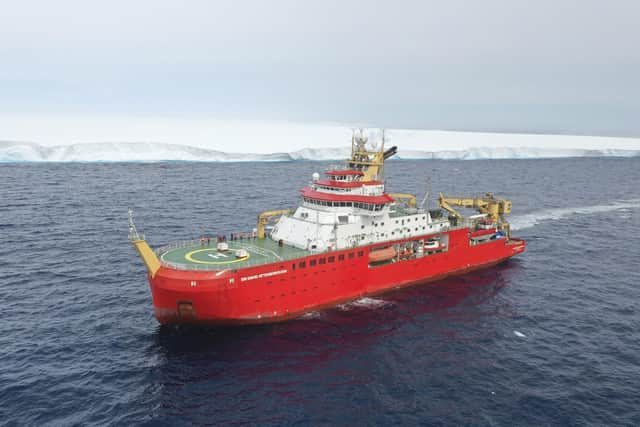British research ship RRS Sir David Attenborough crosses paths with world’s largest iceberg in Antarctic
The RRS Sir David Attenborough, which is on its way to Antarctica for its first scientific mission, passed the mega iceberg known as the A23a on Friday near the tip of the Antarctic Peninsula.
The iceberg – equivalent to three times the size of New York City and more than twice the size of Greater London – had been grounded for more than three decades in the Weddell Sea after it split from the Antarctic’s Filchner Ice Shelf in 1986.
Advertisement
Hide AdAdvertisement
Hide AdIt began drifting in recent months, and has now moved into the Southern Ocean, helped by wind and ocean currents.


The British Antarctic Survey said it was now likely to be swept along into “iceberg alley” – a common route for icebergs to float toward the sub-Antarctic island of South Georgia.
Andrew Meijers, chief scientist aboard the research ship, said: “It is incredibly lucky that the iceberg’s route out of the Weddell Sea sat directly across our planned path, and that we had the right team aboard to take advantage of this opportunity.
“We’re fortunate that navigating A23a hasn’t had an impact on the tight timings for our science mission, and it is amazing to see this huge berg in person — it stretches as far as the eye can see.”
Laura Taylor, a scientist working on the ship, said the team took samples of ocean surface waters around the iceberg’s route to help determine what life could form around it and how the iceberg and others like it affect carbon in the ocean.
She said: “We know that these giant icebergs can provide nutrients to the waters they pass through, creating thriving ecosystems in otherwise less productive areas. What we don’t know is what difference particular icebergs, their scale, and their origins can make to that process.”
The RRS Sir David Attenborough, named after the famous naturalist, is on a ten-day science trip that is part of a £9 million project to investigate how Antarctic ecosystems and sea ice drive global ocean cycles of carbon and nutrients.
The British Antarctic Survey said its findings would help improve understanding of how climate change is affecting the Southern Ocean and the organisms that live there.
Advertisement
Hide AdAdvertisement
Hide AdThe £200 million RRS Sir David Attenborough, which has a 30-strong crew with up to 60 scientists and support staff onboard, left its home port of Harwich in Essex last month.
Having visited Portsmouth, in Hampshire, to pick up fuel, the polar research vessel is due to arrive at Rothera Research Station, on the Antarctic peninsula, by Christmas.
Ahead of its departure, Professor Dame Jane Francis, director of British Antarctic Survey, which operates the ship, had said scientists were investigating tipping points “where the earth goes into irreversible change” such as the west Antarctic ice sheet.
She said: “If that ice sheet does melt, it holds about 3-5m of global sea level rise, so what happens in Antarctica won’t just stay in Antarctica, it will affect us all.”
Prof Francis added: “Global sea level is rising quite consistently now, it’s about 3mm to 4mm per year, which doesn’t sound much but that will inundate quite a lot of coastlines around the world.”
Comments
Want to join the conversation? Please or to comment on this article.